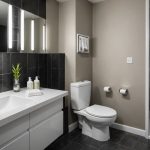Bathroom mold is an all-too-common issue in many windowless UK spaces. Lack of ventilation can create a perfect storm for mold growth, leading to health concerns and unsightly stains. This guide explores effective strategies to combat and prevent mold in these challenging environments. Discover practical tips to improve airflow, maintain cleanliness, and choose the right products to keep your bathroom mold-free, ensuring a healthier living space. Say goodbye to mold and hello to a fresher bathroom experience!
Understanding Bathroom Mold in Windowless Spaces
Mold growth is a common issue in windowless bathrooms, where moisture and humidity levels can become problematic. In such environments, various types of mold, including black mold and mildew, often thrive due to the lack of natural ventilation. This absence of windows creates an ideal breeding ground for mold, as it limits airflow and retains moisture.
A découvrir également : Blending Timeless Tradition with Contemporary Style: A Guide to Restoring Your Tudor Home in Suffolk
Several factors contribute to mold growth in these spaces. High humidity levels, often caused by hot showers, are a primary concern. Without proper ventilation, the moisture accumulates, providing an ideal environment for mold spores to settle and grow. Another critical factor is the presence of organic materials such as wood or drywall, which mold can feed on.
UK homes face specific challenges in managing moisture in windowless bathrooms. The country's damp climate exacerbates the issue, making it crucial to implement effective moisture control strategies. The use of exhaust fans, dehumidifiers, and moisture-resistant materials can help mitigate these problems.
A lire aussi : Unlocking Your Loft: Essential Legal Guidelines for Loft Conversions in Birmingham
Understanding the causes of mold in windowless bathrooms is essential for prevention. By addressing the factors that contribute to mold growth, homeowners can maintain a healthier and more pleasant bathroom environment.
Importance of Ventilation
In windowless bathrooms, ventilation plays a crucial role in preventing mold growth. Without proper airflow, moisture accumulates, creating ideal conditions for mold to thrive. This is especially pertinent in the UK climate, where dampness is already a common challenge.
Effective Ventilation Methods
To combat mold, implementing effective airflow solutions is essential. In the absence of windows, exhaust fans are a popular choice. These fans actively remove moisture-laden air, reducing humidity levels. For optimal performance, choose a fan with the appropriate capacity for your bathroom size.
Dehumidifiers are another effective tool. They work by extracting excess moisture from the air, further reducing the likelihood of mold development. This is particularly beneficial in the UK, where high humidity levels can persist.
Recommended Ventilation Systems
For UK homes, selecting ventilation systems that can handle the local climate is important. Consider systems with humidity sensors that activate automatically when moisture levels rise. Additionally, moisture-resistant materials can be integrated into bathroom design to further inhibit mold growth.
By prioritising ventilation, homeowners can create a healthier environment. This proactive approach not only prevents mold but also enhances the overall comfort and longevity of the bathroom space.
Moisture Control Techniques
Understanding humidity levels is crucial in managing mold in windowless bathrooms. High humidity provides the perfect environment for mold spores to flourish. To combat this, effective moisture management strategies must be employed.
One of the primary strategies is using dehumidifiers. These devices are designed to extract excess moisture from the air, significantly reducing the risk of mold growth. In the UK, where high humidity is common, a dehumidifier can be an essential tool. It's important to choose a model with the right capacity for your bathroom size to ensure optimal performance.
Another strategy involves humidity control through regular monitoring. Humidity sensors are invaluable in this regard, as they can automatically activate ventilation systems when moisture levels rise. This proactive approach helps maintain a balanced environment, preventing moisture accumulation.
Additionally, incorporating moisture-resistant materials in bathroom design can further inhibit mold growth. These materials are specifically designed to withstand damp conditions, providing an extra layer of protection.
For effective moisture control, consider products like exhaust fans with humidity sensors and high-capacity dehumidifiers. By implementing these strategies, homeowners can maintain a healthier bathroom environment, minimizing the risk of mold development.
Cleaning and Maintenance Practices
Maintaining a mold-free bathroom requires consistent cleaning and diligent upkeep. To effectively inhibit mold growth, focus on these best practices:
Cleaning Tips: Regularly clean bathroom surfaces with a mixture of vinegar and water. Vinegar is a natural mold deterrent due to its acidic properties. Ensure all surfaces, including tiles and grout lines, are thoroughly scrubbed to remove any mold spores. For tougher stains, consider using a baking soda paste.
Recommended Cleaning Products: Utilise products specifically designed for mold prevention, such as those containing hydrogen peroxide or tea tree oil. These ingredients are effective in killing mold spores and preventing their return. Always follow the manufacturer's instructions for safe and effective use.
Regular Maintenance Tips: To prevent mold, ensure your bathroom is dry after use. Wipe down walls and floors, and leave the door open to promote air circulation. Regularly check for leaks in plumbing fixtures, as even minor drips can contribute to moisture accumulation. Replace worn-out caulking around bathtubs and sinks to prevent water seepage.
By integrating these cleaning and maintenance practices, you can significantly reduce the risk of mold development, ensuring a hygienic and pleasant bathroom environment.
Product Recommendations
When tackling bathroom mold, selecting the right mold-resistant products is essential. In the UK, various cleaning supplies are designed to combat mold effectively. Here’s an overview of what to consider:
Mold-Resistant Paints and Materials
Opting for mold-resistant paints can significantly reduce mold growth. These paints contain antimicrobial agents that prevent mold spores from settling. They're ideal for damp environments like windowless bathrooms, offering a protective barrier that prolongs the lifespan of your walls.
Recommended UK Brands
Several UK brands offer cleaning supplies specifically for mold prevention. Products containing hydrogen peroxide or tea tree oil are particularly effective. These natural ingredients kill mold spores and inhibit their return. Look for brands that highlight these components in their formulas for optimal results.
Comparing Mold Prevention Effectiveness
When comparing brands, consider their mold prevention effectiveness. Some brands may offer additional features like moisture resistance or ease of application. Reviews and user feedback can be invaluable in determining which products perform best in real-world conditions.
By choosing the right mold-resistant products and cleaning supplies, you can effectively manage mold in your windowless bathroom, ensuring a cleaner and healthier space.
Safety Precautions When Dealing with Mold
Dealing with mold safety is vital to protect your health and home. Exposure to mold can lead to various health risks, including respiratory issues, allergies, and skin irritation. It's essential to understand these risks to take appropriate action.
Health Risks Associated with Mold Exposure
Mold releases spores that can be inhaled, potentially causing respiratory problems such as asthma or bronchitis. Individuals with allergies or weakened immune systems are particularly vulnerable. Prolonged exposure can exacerbate symptoms, making it crucial to address mold issues promptly.
Safety Measures for DIY Mold Removal
If you decide to tackle mold removal yourself, follow strict removal guidelines to ensure safety. Wear protective gear like gloves, masks, and goggles to prevent direct contact with mold spores. Ensure the area is well-ventilated to reduce inhalation risks. Use appropriate cleaning agents, such as vinegar or hydrogen peroxide, to effectively eliminate mold.
When to Consult Professionals for Mold Issues
In cases of extensive mold growth or persistent health symptoms, it's advisable to consult professionals. They have the expertise and equipment to safely and thoroughly remove mold, minimizing health risks. Professional intervention is particularly recommended if mold has penetrated structural materials, as improper handling can worsen the situation.
Case Studies of Successful Mold Management
Exploring success stories in mold management offers valuable insights into effective prevention strategies. In the UK, homeowners have tackled mold challenges with varying approaches, each yielding unique outcomes.
One notable mold management case study involves a family in Manchester who transformed their windowless bathroom. By installing a high-capacity exhaust fan and using mold-resistant paint, they significantly reduced humidity and mold presence. Their success highlights the importance of combining ventilation with protective coatings.
Another UK example is a couple in Bristol who faced persistent mold due to the region's damp climate. They opted for a comprehensive approach, integrating a dehumidifier and moisture-resistant materials. This dual strategy not only curbed mold growth but also enhanced their bathroom's durability.
Lessons learned from these experiences underscore the necessity of tailored solutions. Effective mold management often requires a combination of ventilation improvements, moisture control, and regular maintenance. Analyzing these case studies reveals that proactive measures and informed decisions are key to overcoming mold challenges.
By examining these real-life examples, homeowners can better understand the diverse strategies available, ultimately leading to more effective mold prevention in windowless bathrooms.
Seasonal Considerations for Mold Prevention
The UK weather impact on mold growth is significant, with each season presenting unique challenges. During the damp winter months, moisture levels rise, creating favourable conditions for seasonal mold growth in bathrooms. In contrast, the warmer summer months can lead to increased humidity, further exacerbating mold issues in windowless spaces.
To effectively combat these seasonal variations, homeowners should adapt their climate adaptation strategies. In winter, focus on enhancing insulation and using moisture-resistant materials to prevent condensation. Regularly check for leaks and ensure that exhaust fans are functioning optimally to maintain airflow.
Spring and autumn bring fluctuating temperatures, requiring vigilant monitoring of humidity levels. Seasonal maintenance tips include using dehumidifiers to manage excess moisture and applying mold-resistant paints to protect surfaces. Regular cleaning with mold-preventive solutions is also crucial.
During summer, when humidity peaks, increase ventilation by leaving bathroom doors open and using fans to circulate air. Consider investing in a high-capacity dehumidifier to tackle persistent moisture.
By adjusting practices according to seasonal changes, homeowners can effectively reduce the risk of mold growth, ensuring a healthier bathroom environment year-round.
Resources and Further Reading
For those seeking comprehensive mold resources, understanding the best practices in prevention and management is crucial. The UK offers a wealth of guidelines that can aid homeowners in tackling mold issues effectively.
Authoritative Resources on Mold Prevention
- UK Government Publications: These include detailed guidelines on managing mold in residential spaces, addressing both prevention and remediation.
- Environmental Health Agencies: Agencies like Public Health England provide insights into mold's health impacts and practical advice on reducing exposure.
Recommended Reading for Homeowners
Homeowners should explore literature that delves into mold management strategies tailored for the UK climate. Books and articles focusing on ventilation improvements and moisture control are particularly beneficial. These readings offer a deeper understanding of how to maintain a mold-free environment.
Expert Advice and Contact Information
For personalized guidance, consider reaching out to certified mold specialists. These experts can provide tailored advice and solutions based on individual circumstances. Contact information for local services can often be found through environmental health directories.
By leveraging these resources, homeowners can equip themselves with the knowledge and tools necessary to effectively manage mold in their windowless bathrooms.











